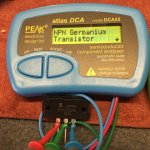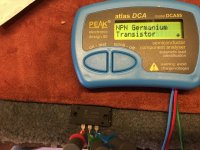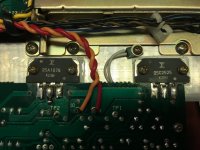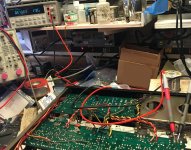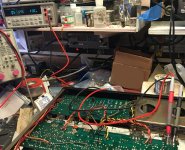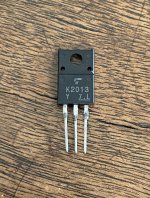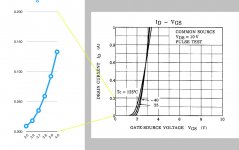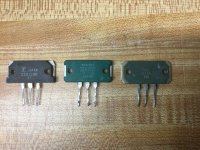So I was wondering if any of you have come across some of these parts:
Fujitsu: 2sc2526
The parts I have show to be germanium????
On my Atlas DCA55 tester? WTF Over?
Anyone test any of these?
The actual reading from the DCA55 follow:
1) Hfe = 43 Vbe=0.54V DiodeCheck BC= .489 BE= .497
2) Hfe = 40 Vbe=0.54V DiodeCheck BC= .494 BE= .501
Tested the known good silicon device in the amp:
DiodeCheck BC= .570 BE= .573
Are these "NEW" Fujitsu ring emitters that good that the
PN junction is that low?
I've got New close complimentary Toshiba silicons,
1) BC= .570 BE= .570
2) BC= .558 BE+ .562
Tested the known good device in the amp:
BC=.545 BE=.551
Anyone else Test any of these?
Cheers,
Fujitsu: 2sc2526
The parts I have show to be germanium????
On my Atlas DCA55 tester? WTF Over?
Anyone test any of these?
The actual reading from the DCA55 follow:
1) Hfe = 43 Vbe=0.54V DiodeCheck BC= .489 BE= .497
2) Hfe = 40 Vbe=0.54V DiodeCheck BC= .494 BE= .501
Tested the known good silicon device in the amp:
DiodeCheck BC= .570 BE= .573
Are these "NEW" Fujitsu ring emitters that good that the
PN junction is that low?
I've got New close complimentary Toshiba silicons,
1) BC= .570 BE= .570
2) BC= .558 BE+ .562
Tested the known good device in the amp:
BC=.545 BE=.551
Anyone else Test any of these?
Cheers,
Attachments
dotneck335, not necessarily.
Uber, I'm not sure if that is the reason.
But, when I diode check BC to BE,
it reads, below .5V or near .5v.
Yes, Vbe below .5 or there abouts when it
we know its .7V across the PN junction.
Slightly less, .65 or high .57 ect.
I'd like to see if anyone has measured their
devices and compare.
Cheers,
Uber, I'm not sure if that is the reason.
But, when I diode check BC to BE,
it reads, below .5V or near .5v.
Yes, Vbe below .5 or there abouts when it
we know its .7V across the PN junction.
Slightly less, .65 or high .57 ect.
I'd like to see if anyone has measured their
devices and compare.
Cheers,
I think its more like:
eBay: all bets are off (real / real NOS / recycled / fake / non-functional are all possible)
Mouser/Farnell/digikey/etc: real
Anyway the low Vbe is because they are high current transistors and the tester doesn't know this. Vbe depends on
current density, not total device current.
eBay: all bets are off (real / real NOS / recycled / fake / non-functional are all possible)
Mouser/Farnell/digikey/etc: real
Anyway the low Vbe is because they are high current transistors and the tester doesn't know this. Vbe depends on
current density, not total device current.
Fake or real 2SK2013?
I'm trying to determine if some 2SK2013s I have are genuine or not. The case looks good (although the placement of the 'Y' grade marking is suspect: I think it's usually under the '2').
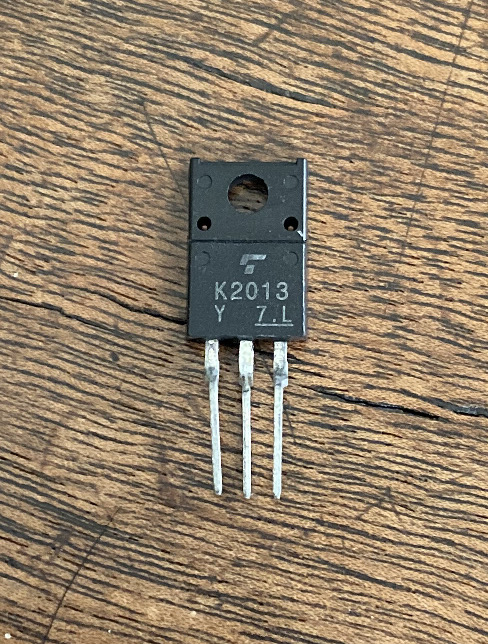
(Pics of other real & fake 2SK2013s can be found here: https://www.diyaudio.com/forums/pass-labs/168040-f5-2sk2013-2sj313-25.html#post2658976. )
I did some manual curve tracing with a couple of bench supplies. This is ID over VGS, with VDS fixed at 10V:
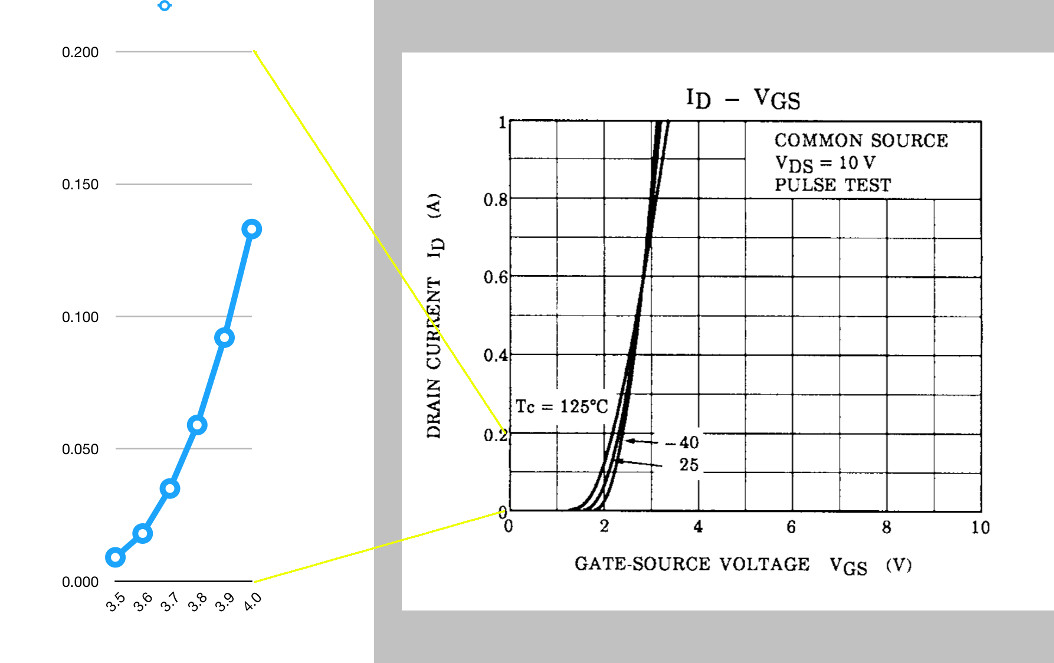
While the curve looks about right, note that it's offset to the right by about 1.8V. I know the curve in the datasheet is only representative, but would there be that much variation in VGS?
Thanks,
Jeff.
I'm trying to determine if some 2SK2013s I have are genuine or not. The case looks good (although the placement of the 'Y' grade marking is suspect: I think it's usually under the '2').
(Pics of other real & fake 2SK2013s can be found here: https://www.diyaudio.com/forums/pass-labs/168040-f5-2sk2013-2sj313-25.html#post2658976. )
I did some manual curve tracing with a couple of bench supplies. This is ID over VGS, with VDS fixed at 10V:
While the curve looks about right, note that it's offset to the right by about 1.8V. I know the curve in the datasheet is only representative, but would there be that much variation in VGS?
Thanks,
Jeff.
Attachments
Sync,
the one on your tester looks like it was laser engraved, as do many current offerings on fleabay of transistors that went out of production in the 80s. Probably fishy.
Out of curiosity: what amp model is that on your test bench? It's also hard to see, but the green transistor looks like it has a flourised Toshiba T on it? Was it a mixed Toshiba / Fujitsu out of the box?
I know some Aiwas had Fujitsu trannies spec'ed in the schematic but came either with a pair of black Fujitsus or a pair of green and black Toshibas.
the one on your tester looks like it was laser engraved, as do many current offerings on fleabay of transistors that went out of production in the 80s. Probably fishy.
Out of curiosity: what amp model is that on your test bench? It's also hard to see, but the green transistor looks like it has a flourised Toshiba T on it? Was it a mixed Toshiba / Fujitsu out of the box?
I know some Aiwas had Fujitsu trannies spec'ed in the schematic but came either with a pair of black Fujitsus or a pair of green and black Toshibas.
I would look at them with suspicion too. That new Fujitsu is in the Toshiba version of the case. Fujitsu, Toshiba, and NEC all have different moldings for the epoxy case.
0.5 Vbe is par for the course on power transistors this size, ring emitter, epi-base or whatever. Even 3055’s will measure that low.
0.5 Vbe is par for the course on power transistors this size, ring emitter, epi-base or whatever. Even 3055’s will measure that low.
Attachments
Eric, Thanks for the PM reminder.
The amp is a Pioneer SA-7800. One of the pots on the left channel of the amp
must have bounced and took out that channel of the amp, emitter resistors and fried other resistors,
probably damaged the driver transistors too.
The SA-7800 is one of the series of amps that have their NSA (Non-Switching Amplifier) Circuit.
From what I have since learned, these NSA Circuit amps are notorious for frying the outputs,
the emitter resistors, other resistors and the driver transistors. If not caught quickly, both channels will fry.
We can't just go and replace parts without testing everything on the initial
fried channel. It's known to fry the new parts also. And will just keep doing it.
So, we must verify and test everything on the channel, resistors, transistors,
capacitors, diodes, before replacing the output transistors.
Exactly. I got purchased a full set of output devices for this amp (both sides).
Then I got one green and black of differeing types Green 2sa1075 and black 2sc2526.
I was not happy when I received one Toshiba and one Fujitsu for each channel.
Yes, from a highly rated (fleabay) guy in NJ who sells these hard to find parts.
When I informed him of the difficulty matching different manufactures output devices,
especially in this amp, it could cause problems.
So he sent me the other device. Buy that device
is slightly different also, it's the Fujitsu 2sc2526.
So it may be original. But it should be paired with the Fujitsu 2sa1076.
But as you saw, i received the Toshiba 2sa1075.
Eventually diyAudio member cowboy99, has these NOS devices and
I bought the proper ones from him. I have the left channel finished
Now I need to change the right channel. Once those are confirmed to
work properly...then I can replace the other marginal parts in both channels
and refresh all the caps too, suspect diodes and driver transistors.
You got the long version, Eric.
Cheers,
I think it was a lighting issue or iPhone camera at slightly different angle.Sync,
the one on your tester looks like it was laser engraved, as do many current offerings on fleabay
of transistors that went out of production in the 80s. Probably fishy.
That green Toshiba and black Fujitsu was one of the two pair if mismatched transisors for the amp.Out of curiosity: what amp model is that on your test bench?
It's also hard to see, but the green transistor looks like it has a flourised Toshiba T on it?
Was it a mixed Toshiba / Fujitsu out of the box?
The amp is a Pioneer SA-7800. One of the pots on the left channel of the amp
must have bounced and took out that channel of the amp, emitter resistors and fried other resistors,
probably damaged the driver transistors too.
The SA-7800 is one of the series of amps that have their NSA (Non-Switching Amplifier) Circuit.
From what I have since learned, these NSA Circuit amps are notorious for frying the outputs,
the emitter resistors, other resistors and the driver transistors. If not caught quickly, both channels will fry.
We can't just go and replace parts without testing everything on the initial
fried channel. It's known to fry the new parts also. And will just keep doing it.
So, we must verify and test everything on the channel, resistors, transistors,
capacitors, diodes, before replacing the output transistors.
I know some Aiwas had Fujitsu trannies spec'ed in the schematic
but came either with a pair of black Fujitsus or a pair of green and black Toshibas.
Exactly. I got purchased a full set of output devices for this amp (both sides).
Then I got one green and black of differeing types Green 2sa1075 and black 2sc2526.
I was not happy when I received one Toshiba and one Fujitsu for each channel.
Yes, from a highly rated (fleabay) guy in NJ who sells these hard to find parts.
When I informed him of the difficulty matching different manufactures output devices,
especially in this amp, it could cause problems.
So he sent me the other device. Buy that device
is slightly different also, it's the Fujitsu 2sc2526.
So it may be original. But it should be paired with the Fujitsu 2sa1076.
But as you saw, i received the Toshiba 2sa1075.
Eventually diyAudio member cowboy99, has these NOS devices and
I bought the proper ones from him. I have the left channel finished
Now I need to change the right channel. Once those are confirmed to
work properly...then I can replace the other marginal parts in both channels
and refresh all the caps too, suspect diodes and driver transistors.
You got the long version, Eric.
Cheers,
Last edited:
Thanks (I asked for it). I just bought a bonsai Aiwa power stage (separate preamp needed). That cute little thing worked right out of the box after 40 years, no hum, no need to replace caps and very laid back sound. From what I had researched, people had only come across Toshibas even if the schematic specified Fujitsu A1075/C2525, but mine had them.
So I was looking into what little is known about these transistors and what other amps used them. It is awfully hard to find out which period amps actually used ring emitter transistors without having a model number and systematically searching for the schematic. I also found that a surprising number of 70s amps used TO3 output devices with three digit part numbers that had an ft of 15 - 20 MHz without being RET.
I had heard about the non-switching design but never even looked at a schematic before you mentioned it. I will have to find a better scan to really understand how it works, though.
So I was looking into what little is known about these transistors and what other amps used them. It is awfully hard to find out which period amps actually used ring emitter transistors without having a model number and systematically searching for the schematic. I also found that a surprising number of 70s amps used TO3 output devices with three digit part numbers that had an ft of 15 - 20 MHz without being RET.
I had heard about the non-switching design but never even looked at a schematic before you mentioned it. I will have to find a better scan to really understand how it works, though.
Last edited:
- Home
- Design & Build
- Parts
- Fake or Real Fujitsu Part?
